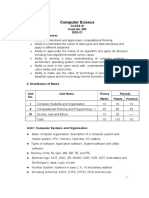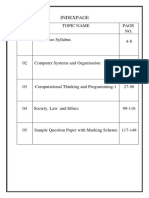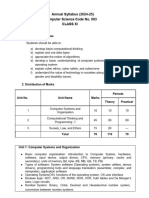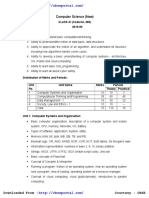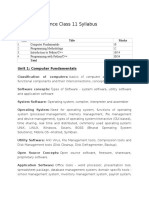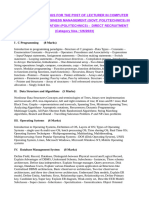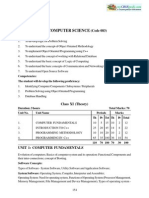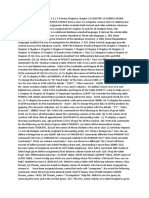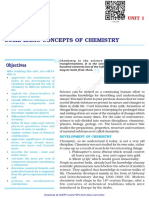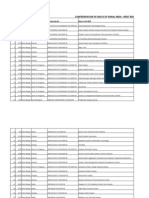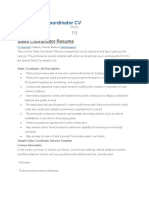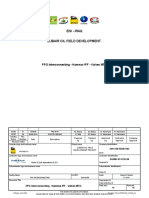0 ratings0% found this document useful (0 votes)
25 viewsPortion For Class XI
Portion For Class XI
Uploaded by
rekha_1234This document outlines the curriculum for Computer Science (Revised) for Class XI. It covers 3 units: 1) Computer Systems and Organisation, which discusses computer hardware, software, number systems, and operating systems. 2) Computational Thinking and Programming-1, which introduces problem solving techniques, Python programming basics like variables, data types, operators, conditional and iterative statements, and data structures like strings, lists, tuples, and dictionaries. 3) Society, Law and Ethics, covering topics like cyber safety, intellectual property, privacy laws, cybercrime, technology's impact on society, and e-waste management.
Copyright:
© All Rights Reserved
Available Formats
Download as DOCX, PDF, TXT or read online from Scribd
Portion For Class XI
Portion For Class XI
Uploaded by
rekha_12340 ratings0% found this document useful (0 votes)
25 views3 pagesThis document outlines the curriculum for Computer Science (Revised) for Class XI. It covers 3 units: 1) Computer Systems and Organisation, which discusses computer hardware, software, number systems, and operating systems. 2) Computational Thinking and Programming-1, which introduces problem solving techniques, Python programming basics like variables, data types, operators, conditional and iterative statements, and data structures like strings, lists, tuples, and dictionaries. 3) Society, Law and Ethics, covering topics like cyber safety, intellectual property, privacy laws, cybercrime, technology's impact on society, and e-waste management.
Original Description:
portion for class XI
Original Title
portion for class XI
Copyright
© © All Rights Reserved
Available Formats
DOCX, PDF, TXT or read online from Scribd
Share this document
Did you find this document useful?
Is this content inappropriate?
This document outlines the curriculum for Computer Science (Revised) for Class XI. It covers 3 units: 1) Computer Systems and Organisation, which discusses computer hardware, software, number systems, and operating systems. 2) Computational Thinking and Programming-1, which introduces problem solving techniques, Python programming basics like variables, data types, operators, conditional and iterative statements, and data structures like strings, lists, tuples, and dictionaries. 3) Society, Law and Ethics, covering topics like cyber safety, intellectual property, privacy laws, cybercrime, technology's impact on society, and e-waste management.
Copyright:
© All Rights Reserved
Available Formats
Download as DOCX, PDF, TXT or read online from Scribd
Download as docx, pdf, or txt
0 ratings0% found this document useful (0 votes)
25 views3 pagesPortion For Class XI
Portion For Class XI
Uploaded by
rekha_1234This document outlines the curriculum for Computer Science (Revised) for Class XI. It covers 3 units: 1) Computer Systems and Organisation, which discusses computer hardware, software, number systems, and operating systems. 2) Computational Thinking and Programming-1, which introduces problem solving techniques, Python programming basics like variables, data types, operators, conditional and iterative statements, and data structures like strings, lists, tuples, and dictionaries. 3) Society, Law and Ethics, covering topics like cyber safety, intellectual property, privacy laws, cybercrime, technology's impact on society, and e-waste management.
Copyright:
© All Rights Reserved
Available Formats
Download as DOCX, PDF, TXT or read online from Scribd
Download as docx, pdf, or txt
You are on page 1of 3
Computer Science
(Revised)
CLASS-XI
Code No. 083
2020-21
Ability to understand and apply basic computational thinking.
Ability to understand the notion of data types and data structures and apply in different situations.
Ability to appreciate the notion of an algorithm and apply its structure including how algorithms
handle corner cases.
Ability to develop a basic understanding of computer systems -
architecture, operating system, mobile and cloud computing.
Ability to work in the cyber world with understanding of cyber ethics, cyber safety and cybercrime
Ability to make use the value of technology in societies, gender and disability issues and the
technology behind biometric ids.
Unit I: Computer Systems and Organisation
● Basic computer organisation: description of a computer system and
mobile system, CPU, memory, hard disk, I/O, battery.
● Types of software: Application software, System software and Utility
software.
● Memory Units: bit, byte, MB, GB, TB, and PB.
● Boolean logic: NOT, AND, OR, NAND, NOR, XOR, NOT, truth tables and
De Morgan’s laws, Logic circuits
● Number System: numbers in base 2, 8, 16 and binary addition.
● Encoding Schemes : ASCII, ISCII and Unicode
● Concept of Compiler and Interpreter
● Operating System (OS) - need for an operating system, brief introduction
to functions of OS, user interface
Unit II: Computational Thinking and Programming – 1
Introduction to Problem solving: Problem solving cycle - Analysing a problem,
designing algorithms and representation of algorithm using flowchart and
pseudo-code.
Familiarization with the basics of Python programming: a simple “hello world"
program, the process of writing a program (Interactive & Script mode),
running it and print statements; simple data-types: integer, float and string.
● Features of Python, Python Character Set, Token & Identifiers, Keywords,
Literals, Delimiters, Operators.
● Comments: (Single line & Multiline/ Continuation statements), Clarity &
Simplification of expression
● Introduce the notion of a variable and methods to manipulate it (concept of
L-value and R-value even if not taught explicitly).
● Knowledge of data types and operators: accepting input from the console,
assignment statement, expressions, operators and their precedence.
● Operators & types: Binary operators-Arithmetic, Relational Operators,
Logical Operators, Augmented Assignment Operators.
● Execution of a program, errors- syntax error, run-time error and logical
error.
● Conditional statements: if, if-else, if-elif-else; simple programs: e.g.:
absolute value, sort 3 numbers and divisibility of a number.
● Notion of iterative computation and control flow: for(range(),len()), while,
using flowcharts, suggested programs: calculation of simple and compound
interests, finding the factorial of a positive number etc.
● Strings: Traversal, operations – concatenation, repetition, membership;
functions/methods–len(), capitalize(), title(), upper(), lower(), count(), find(),
index(), isalnum(), islower(), isupper(), isspace(), isalpha(), isdigit(), split(),
partition(), strip(), lstrip(), rstrip(), replace(); String slicing.
● Lists: Definition, Creation of a list, Traversal of a list. Operations on a list -
concatenation, repetition, membership; functions/methods–len(), list(),
append(), extend(), insert(), count(), index(), remove(), pop(), reverse(), sort(),
min(), max(), sum(); Lists Slicing; Nested lists; finding the maximum, minimum,
mean of numeric values stored in a list; linear search on list of numbers and
counting the frequency of elements in a list.
● Tuples: Definition, Creation of a Tuple, Traversal of a tuple. Operations on
a tuple - concatenation, repetition, membership; functions/methods –
len(), tuple(), count(), index(), sorted(), min(), max(), sum(); Nested tuple;
Tuple slicing; finding the minimum, maximum, mean of values stored in a
tuple; linear search on a tuple of numbers, counting the frequency of
elements in a tuple.
● Dictionary: Definition, Creation, Accessing elements of a dictionary, add an
item, modify an item in a dictionary; Traversal, functions/methods – len(),
dict(), keys(), values(), items(), get(), update(), del(), del, clear(),
fromkeys(), copy(), pop(), popitem(), setdefault(), max(), min(), count(),
sorted() copy(); Suggested programs : count the number of times a
character appears in a given string using a dictionary, create a dictionary
with names of employees, their salary and access them.
● Introduction to Python modules: Importing math module (pi, e, sqrt, ceil,
floor, pow, fabs, sin, cos, tan); random module (random, randint,
randrange), statistics module (mean, median, mode).
Unit III: Society, Law and Ethics
1. Cyber safety: safely browsing the web, identity protection, confidentiality,social networks, cyber
trolls and bullying.
2. Appropriate usage of social networks: spread of rumours, and common social networking sites
(Twitter, LinkedIn, and Facebook) and specific usage rules.
3. Safely accessing web sites: adware, malware, viruses, trojans
4. Safely communicating data: secure connections, eavesdropping, phishing and identity verification.
5. Intellectual property rights, plagiarism, digital rights management,and licensing (Creative Commons,
GPL and Apache), open source, open data,privacy.
6. Privacy laws, fraud; cyber-crime- phishing, illegal downloads, child pornography, scams; cyber
forensics, IT Act, 2000.
7. Technology and society:
8. understanding of societal issues and cultural changes induced by technology.
9. E-waste management: proper disposal of used electronic gadgets.
You might also like
- Week 5 Graded Jan 2022 EMQ PATTERNDocument2 pagesWeek 5 Graded Jan 2022 EMQ PATTERNrekha_123467% (3)
- Computer Science VportionsDocument6 pagesComputer Science Vportionsrekha_1234No ratings yet
- Comp - SC Syllabus 23-24class XIDocument4 pagesComp - SC Syllabus 23-24class XItryambakabanerjeeNo ratings yet
- REVISEDComputer Science SR - Sec 2020-21 PDFDocument10 pagesREVISEDComputer Science SR - Sec 2020-21 PDFVikas KhareNo ratings yet
- REVISED11 - SR - SEC. - Computer Science - 2020-21Document5 pagesREVISED11 - SR - SEC. - Computer Science - 2020-21Prasanta K PattadarNo ratings yet
- CS2021 XiDocument5 pagesCS2021 XiJananicharlesrajNo ratings yet
- XI-CS Study Material 2023-24Document142 pagesXI-CS Study Material 2023-242pwxanqt8aNo ratings yet
- Computer Science SrSec 2024-25Document8 pagesComputer Science SrSec 2024-25rohitpatra708024No ratings yet
- XI-CS Material 2023-24Document107 pagesXI-CS Material 2023-24Aanand BangarNo ratings yet
- Computer Science: Basic Computer Organisation: Description of A Computer SystemDocument5 pagesComputer Science: Basic Computer Organisation: Description of A Computer SystemAtanuBhandaryNo ratings yet
- XI-CS Study Material 2023-24Document142 pagesXI-CS Study Material 2023-24Thariq SNo ratings yet
- XI-Opt. Syllabus (2023-24)Document29 pagesXI-Opt. Syllabus (2023-24)INDERDEEPNo ratings yet
- Computer Science: (Code 083)Document5 pagesComputer Science: (Code 083)api-243565143No ratings yet
- 11 CS Split-Up Syllabus 2023-2024Document4 pages11 CS Split-Up Syllabus 2023-2024ronisharora11No ratings yet
- 11 Computerscience Eng 2024 25Document4 pages11 Computerscience Eng 2024 25ayushrajput110809No ratings yet
- Learning Outcomes: Computer Science Class-Xi Code No. 083 2021-22Document4 pagesLearning Outcomes: Computer Science Class-Xi Code No. 083 2021-22Dhruv jainNo ratings yet
- Downloaded From:: Computer Science (New)Document4 pagesDownloaded From:: Computer Science (New)Yogesh BaghelNo ratings yet
- Curriculum Bifurcation Format 25-26 (CS) (1)Document11 pagesCurriculum Bifurcation Format 25-26 (CS) (1)aayannkjainNo ratings yet
- CMS Computer Science SrSec 2024-25Document9 pagesCMS Computer Science SrSec 2024-25priyanshurajgopiNo ratings yet
- Termwise Syllabus Class - XI Computer Science (New) Code No. 083 Session 2019-20Document3 pagesTermwise Syllabus Class - XI Computer Science (New) Code No. 083 Session 2019-20Mobin Ahmed KingNo ratings yet
- Learning Outcomes: Computer Science Class - Xi Code No. 083 2021-22Document10 pagesLearning Outcomes: Computer Science Class - Xi Code No. 083 2021-22shivam namdevNo ratings yet
- Learning Outcomes: Computer Science Class-Xi Code No. 083 2021-22Document8 pagesLearning Outcomes: Computer Science Class-Xi Code No. 083 2021-22dadan vishwakarmaNo ratings yet
- Class XI Python Material KV SangthanDocument143 pagesClass XI Python Material KV SangthanBiju0% (1)
- Syllabus Computer Science 2024 XIIDocument4 pagesSyllabus Computer Science 2024 XIIharshsingh14oct2006No ratings yet
- Computer Science: (Code 083)Document5 pagesComputer Science: (Code 083)api-243565143No ratings yet
- bseb computer scienceDocument7 pagesbseb computer scienceunknown610112No ratings yet
- CS Split Class Xi 2022-23 - 0Document4 pagesCS Split Class Xi 2022-23 - 0creativelordzxNo ratings yet
- 11 CS SSM 2022-23 AhmdDocument113 pages11 CS SSM 2022-23 AhmdVivek ShrivastavaNo ratings yet
- Computer Science Class 11 SyllabusDocument7 pagesComputer Science Class 11 SyllabusSamit BasuNo ratings yet
- Kvs PGT Syllabus 3430f2d2Document26 pagesKvs PGT Syllabus 3430f2d2amanojcs02No ratings yet
- Computer Science (Code 083)Document10 pagesComputer Science (Code 083)praveen_27No ratings yet
- JNTUH MCA Syllabus 2013Document107 pagesJNTUH MCA Syllabus 2013SRINIVASA RAO GANTANo ratings yet
- Computer Science SrSec 2023-24Document9 pagesComputer Science SrSec 2023-24ADITYA BHATNAGARNo ratings yet
- Computer Science 11thDocument1 pageComputer Science 11thsachinjangra7612No ratings yet
- Class Xi Term 2 Syllabus - 1664359133511Document26 pagesClass Xi Term 2 Syllabus - 1664359133511mehul chakrabartiNo ratings yet
- Computer Science SrSec 2023-24Document9 pagesComputer Science SrSec 2023-24ishan29692969No ratings yet
- List of CoursesDocument19 pagesList of Coursesmsukd885560No ratings yet
- Informatics Practices (Code No. 065) : Course DesignDocument11 pagesInformatics Practices (Code No. 065) : Course DesignSonika DograNo ratings yet
- Computer Science Curriculum PDFDocument12 pagesComputer Science Curriculum PDFAmar Singh RajputNo ratings yet
- Unit 1: Computer Fundamentals: Class XI (Theory)Document3 pagesUnit 1: Computer Fundamentals: Class XI (Theory)Sudhakar RNo ratings yet
- CBSE Class 11 Computer Science Syllabus 2023 24Document4 pagesCBSE Class 11 Computer Science Syllabus 2023 24akshdeep1807No ratings yet
- Arti FinalDocument13 pagesArti Finalavijit.das.3.7.1994No ratings yet
- 1a. Computer - ApplicationDocument4 pages1a. Computer - Applicationsuma120619No ratings yet
- 15 Informatics Practices OLDDocument11 pages15 Informatics Practices OLDSumit TiroleNo ratings yet
- 2013 Syllabus 11 Computer ScienceDocument5 pages2013 Syllabus 11 Computer ScienceJacob ChakoNo ratings yet
- Computer Science SylabusDocument10 pagesComputer Science SylabusJagannath JagguNo ratings yet
- Fy BSC Computer ScienceDocument7 pagesFy BSC Computer ScienceHemlata GuptaNo ratings yet
- COMPUTER SCIENCE Syllabus MID TERMDocument2 pagesCOMPUTER SCIENCE Syllabus MID TERMsusamgous15No ratings yet
- KVS PGT Computer Science Syllabus PDF 2022Document5 pagesKVS PGT Computer Science Syllabus PDF 2022balajiNo ratings yet
- BPSC PGT Computer Science Teacher Detailed SyllabusDocument6 pagesBPSC PGT Computer Science Teacher Detailed Syllabuschinmay.kshitijNo ratings yet
- Computer ScienceDocument10 pagesComputer SciencevishvadeepchopadeNo ratings yet
- Informatics Practices (Code No. 065) : Course DesignDocument11 pagesInformatics Practices (Code No. 065) : Course DesignAnurag BhartiNo ratings yet
- Syllabus 11 Computer Science 2013Document4 pagesSyllabus 11 Computer Science 2013microdotcdmNo ratings yet
- Computer Science Class NotesDocument3 pagesComputer Science Class Notesxh7xyn8qsbNo ratings yet
- Reduced Computer Syllabus For Class XIDocument3 pagesReduced Computer Syllabus For Class XIAniruddha MishraNo ratings yet
- Coa, Com, Co Lam SyllabusDocument4 pagesCoa, Com, Co Lam Syllabusnaga sitaram mNo ratings yet
- MR22 3-1 and 3-2Document68 pagesMR22 3-1 and 3-2write2pranathiNo ratings yet
- Class 11 Python 19-20Document5 pagesClass 11 Python 19-20Pragya PandyaNo ratings yet
- CS 1Document2 pagesCS 1meenakvs2007No ratings yet
- Computer Skills: Understanding Computer Science and Cyber Security (2 in 1)From EverandComputer Skills: Understanding Computer Science and Cyber Security (2 in 1)No ratings yet
- Computer Science: The Complete Guide to Principles and InformaticsFrom EverandComputer Science: The Complete Guide to Principles and InformaticsNo ratings yet
- Up 3Document2 pagesUp 3rekha_1234No ratings yet
- AQ5.1 - Activity Question 1 - Not Graded - IITM Online DegreeDocument3 pagesAQ5.1 - Activity Question 1 - Not Graded - IITM Online Degreerekha_1234No ratings yet
- Quick ConceptsDocument11 pagesQuick Conceptsrekha_1234No ratings yet
- Quick Start GuideDocument4 pagesQuick Start Guiderekha_1234No ratings yet
- Some Basic Concepts of Chemistry: Unit 1Document28 pagesSome Basic Concepts of Chemistry: Unit 1rekha_1234No ratings yet
- States of Matter: Unit 5Document24 pagesStates of Matter: Unit 5rekha_1234No ratings yet
- Chemistry: Textbook For Class XIDocument10 pagesChemistry: Textbook For Class XIrekha_1234No ratings yet
- Chemistry: Textbook For Class XIDocument8 pagesChemistry: Textbook For Class XIrekha_1234No ratings yet
- Thermodynamics: Unit 6Document32 pagesThermodynamics: Unit 6rekha_1234No ratings yet
- A Defensive DiamondDocument5 pagesA Defensive Diamondrekha_1234No ratings yet
- Computer Science: and Python Programming With PracticalDocument23 pagesComputer Science: and Python Programming With Practicalrekha_1234No ratings yet
- Sample Paper Syllabus 2017-18: ClassDocument2 pagesSample Paper Syllabus 2017-18: Classrekha_1234No ratings yet
- WBDocument72 pagesWBrekha_1234No ratings yet
- Math10 (CH 6)Document5 pagesMath10 (CH 6)Zachary FongNo ratings yet
- AG - Sales Coordinator CVDocument5 pagesAG - Sales Coordinator CVFahad HassanNo ratings yet
- Armafix Af: Install It. Trust ItDocument3 pagesArmafix Af: Install It. Trust ItPrasad BhattacharyaNo ratings yet
- 251111dtebd1192 Exde01 04Document4 pages251111dtebd1192 Exde01 04Mohammed HijaziNo ratings yet
- Cerabeads InformationDocument3 pagesCerabeads InformationDimitar PartenovNo ratings yet
- Depression, Anxiety and Stress Among Central Philippine Adventist College Music Students During Covid-19 PandemicDocument134 pagesDepression, Anxiety and Stress Among Central Philippine Adventist College Music Students During Covid-19 PandemicJhunntow TugahanNo ratings yet
- Table Name: Description Important FieldsDocument5 pagesTable Name: Description Important FieldsJyotiraditya Banerjee100% (1)
- Pchs Career Pathways HandoutDocument2 pagesPchs Career Pathways Handoutapi-242176050No ratings yet
- Inert Gas PresentationDocument17 pagesInert Gas PresentationRahmat RanggonangNo ratings yet
- Assignment TLEDocument2 pagesAssignment TLEapi-3826459No ratings yet
- 1a Unit of Work Excerpt WeeblyDocument10 pages1a Unit of Work Excerpt Weeblyapi-518405423No ratings yet
- Approaches To Quantum Error CorrectionDocument29 pagesApproaches To Quantum Error CorrectionLikonStruptelNo ratings yet
- Psychrometrics of DryingDocument7 pagesPsychrometrics of DryingNurul Atikah JapryNo ratings yet
- Rivers PDFDocument13 pagesRivers PDFlatha mukundakumarNo ratings yet
- 1-s2.0-S294989102400188X-mainDocument14 pages1-s2.0-S294989102400188X-maingracipotter150709No ratings yet
- Green Belt Project Reduce Process Wire Loss On Stator ManufacturingDocument9 pagesGreen Belt Project Reduce Process Wire Loss On Stator ManufacturingRajesh KhannaNo ratings yet
- Video Games Advantages and DisadvantagesDocument9 pagesVideo Games Advantages and DisadvantageshamzagngmnsrNo ratings yet
- CH 3 Geometric Model To Predict Wowen Fabric PropertiesDocument60 pagesCH 3 Geometric Model To Predict Wowen Fabric PropertiesAmit pandeyNo ratings yet
- Optimization of Production of Bio Diesel Using Aspen PlusDocument10 pagesOptimization of Production of Bio Diesel Using Aspen PlusSreelakshmi MohanNo ratings yet
- AEMSB - Employee Satisfaction SurveyDocument6 pagesAEMSB - Employee Satisfaction SurveyHafizi HassanNo ratings yet
- Chapter 21-C Language1Document65 pagesChapter 21-C Language1vinodtiwarivtNo ratings yet
- 4th Quarter Solo Test Diass Docx - AtonDocument25 pages4th Quarter Solo Test Diass Docx - AtonNotsla AnabiezaNo ratings yet
- 9080 Optimass 7300 Flowmeter ManualDocument146 pages9080 Optimass 7300 Flowmeter ManualMaruti HuleNo ratings yet
- Engineering Drawing SolutionsDocument20 pagesEngineering Drawing Solutionsmtkhusro92No ratings yet
- Jurnal Psikologi Indonesia Vol 6 No 1 20Document84 pagesJurnal Psikologi Indonesia Vol 6 No 1 20marcelinaNo ratings yet
- Journal of Transport Geography: Richard D. Knowles TDocument4 pagesJournal of Transport Geography: Richard D. Knowles TManuel GutierrezNo ratings yet
- Public Engagement and The Politics of Evidence in An Age of Neoliberalism and Audit Culture in Higher EducationDocument1 pagePublic Engagement and The Politics of Evidence in An Age of Neoliberalism and Audit Culture in Higher EducationDrSpoonerNo ratings yet
- Q1 Minutes To Learn About Graphic OrganizersDocument14 pagesQ1 Minutes To Learn About Graphic OrganizersJohn Benedick BelverNo ratings yet
- Koheras SuperkDocument2 pagesKoheras SuperkprincedottyNo ratings yet
- Silibus Sem 1 - Sem 3 A17Document139 pagesSilibus Sem 1 - Sem 3 A17Hariq Hann0% (1)





